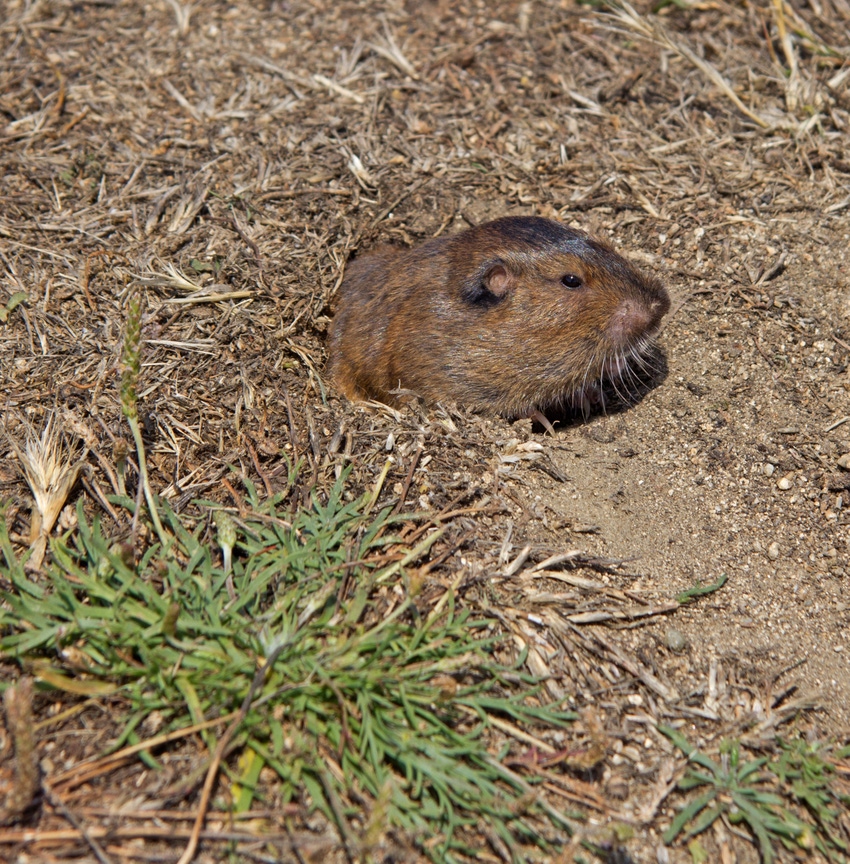
Tree nut growers who are plagued by gopher invasions in their orchards need to stick with effective control measures if they want to minimize tree losses.
Pocket gophers are common in most nut production areas, says Joe Connell, University of California Cooperative Extension Farm Advisor Emeritus in Butte County. In the absence of cover crops or weeds, they will gnaw on tree roots and trunks, and the hungry vertebrate pests can even girdle — and kill — older trees. Trees with root damage and girdling will lose production, and will be susceptible to crown gall, which weakens their structural strength.
Orchards adjacent to pastures or field crops where gophers are not controlled are likely to become infested. Cover crops in orchards are inviting, he says, because they provide gophers with food and protection from predators.
There are five species of pocket gophers in California, with Botta’s pocket gopher being the most common. It ranges in size from 6 inches to 10 inches long, and is well-adapted to a burrowing and digging existence. Fresh mounds of dirt in orchards are a sign of gopher activity. These pests are not often seen, remaining mostly underground in their burrow systems.
CONTROL IN WINTER
Gophers are active all year-round, and winter months, before they begin to reproduce, are the best time to begin control measures. Connell notes that growers will have to remain vigilant, because even if they manage to eradicate the current gopher population, orchards can become reinfested.
January is a perfect time to begin a control program, he says, as mounds will be present to help identify active tunnel systems, and populations will be lower. Ground meant for new orchards should be ripped to destroy existing burrows and prevent immediate reinfestation. But growers and orchard managers should be vigilant because gophers can move back and develop new tunnels. “You have to stay on top of the situation from the beginning,” Connell says.
Trapping can achieve a 90 percent reduction in gopher populations, if efforts continue. Two trapping sessions, one to two weeks apart, will reduce gopher populations and a third trapping may achieve complete removal, if the timing is right. All growers should use trapping, Connell says, because it allows them to target remaining individuals that other measures miss.
Two treatments with aluminum phosphide fumigation can also provide control. The main gopher tunnel must be located with a probe, and the tablets dropped through the hole. The opening must be sealed tightly to keep light from entering or toxic gases from escaping.
Any burrow systems that were missed in the first go-round should be treated. This method requires relatively high soil moisture, and the most effective timing is late winter or early spring.
OTHER MEASURES
Toxic baits, including strychnine-treated grains, are also effective and can be used at 0.5 percent concentration in California. Behavioral resistance can occur over time, and Connell recommends using other control methods in rotation to prevent resistance.
Other materials such as anticoagulants have not proven effective with gophers, because the animals don’t readily eat the baits used to deliver the ingredient. Unlike ground squirrels, gophers won’t ingest enough anticoagulant for a lethal dose.
Growers with large acreages to cover can use a tool called a burrow builder. With the right soil moisture conditions, the burrow builder, pulled behind a tractor, can build new gopher tunnels about 10 inches below the surface. Poison bait can be deposited in the new tunnels, which are placed to intersect existing gopher tunnels. Gophers will explore the new tunnels and find the bait.
Connell emphasizes that regular long-term monitoring, and removal of invaders before they multiply and reestablish, is just part of good orchard management. For additional information, check out the UC IPM Pocket Gopher Pest Note at http://bit.ly/2FokmNn
About the Author(s)
You May Also Like




